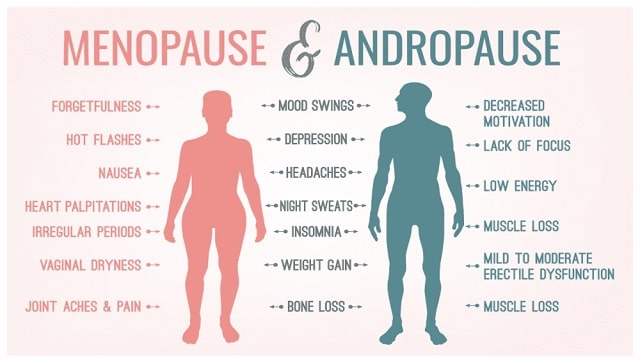Andropause
Male menopause is a more general term for andropause. It describes age-related changes in male hormone levels. The same group of symptoms also has other names, such as testosterone deficiency, androgen deficiency, and hypogonadism with symptoms or delayed progression.
Male menopause involves a decrease in testosterone production in men aged 50 and older. It is also associated with hypogonadism. Both involve decreased testosterone levels and similar symptoms.
Testosterone is a hormone made in the testicles. This hormone has many important roles for men. Not only does it stimulate sexual drive, testosterone also triggers changes during puberty, triggers mental and physical energy, and maintains muscle mass.
Male menopause is different from female menopause in several ways. For one, not all men experience it. In addition, it does not involve a complete cessation of the reproductive organs. However, sexual complications are not impossible due to decreased hormone levels.
Andropause Symptoms
Andropause can cause physical, sexual, and psychological problems for men. In fact, symptoms usually get worse with age, including:
- Low energy levels.
- Depression or often feeling sad
- Motivation and self-confidence decrease.
- Difficulty concentrating.
- Experiencing insomnia or difficulty sleeping.
- Increased body fat.
- Decreased muscle mass and feelings of physical weakness.
- Gynecomastia, or breast development.
- Decreased bone density.
- Erectile dysfunction.
- Decreased libido.
- Increased risk of infertility.
In addition, sufferers may also experience swollen or tender breasts, decreased testicular size, hair loss, and hot flashes. Low testosterone levels associated with male menopause are also associated with osteoporosis.
This is a condition where the bones become weak and brittle. However, bone fragility due to andropause is relatively rare. It usually only affects men at the same age as women enter menopause.
Andropause Risk Factors
Andropause can happen to all men who have entered the age of 50 years or more. However, there are several factors that increase the risk of male menopause, namely:
- Environmental factors, for example, due to exposure to pollution from the environment.
- Internal, including hormonal changes in the male body (prolactin, melatonin, testosterone, dehydroepiandrosterone (DHEA), dehydroepiandrosterone sulfate (DHEA-S), Growth Hormone (GH), and Insulin-like Growth Factor-1 (IGF-1).
- Psychological conditions, including physical and psychological stress.
- Consumption of certain medications.
- Lifestyle, especially unhealthy lifestyle.
- Medical conditions, such as diabetes, COPD, stroke, obesity, kidney problems, metabolic syndrome, autoimmune disorders, and others.
Causes of Andropause
Testosterone decline is a major factor in men with andropause. However, as we age, not only does the body start to make less testosterone, but levels of other hormones, including sex hormone-binding globulin (SHBG), which pulls testosterone from the blood, start to rise. This hormone binds some of the available testosterone circulating in the blood.
Testosterone that is not bound to the SHBG hormone is called bioavailable testosterone, meaning it is available and the body can use it.
Men with symptoms related to andropause have decreased amounts of bioavailable testosterone in the blood. Therefore, tissues in the body that are stimulated by testosterone receive lower amounts. Ultimately, this can lead to various physical and mental changes in a person such as mood swings or fatigue.
Andropause Diagnosis
In order to get a more accurate diagnosis for andropause, doctors will generally do the following things.
- Perform a physical examination.
- Ask about the symptoms.
- Performing additional tests to rule out medical problems that may contribute to the condition.
- Recommend that sufferers have blood tests, which may include measuring testosterone levels.
Andropause Treatment
If testosterone levels are low, testosterone replacement therapy can help relieve symptoms, such as decreased libido, depression, and excessive fatigue.
Like hormone replacement therapy in women, testosterone replacement therapy has potential risks and side effects. Replacing testosterone may increase the risk of prostate cancer and heart disease.
If you are considering androgen replacement therapy, talk to your doctor for more accurate information. Your doctor may also recommend certain lifestyle or other changes to help with some of the symptoms of male menopause. These include diet, exercise programs, and prescription medications such as antidepressants.
Andropause Complications
Complications associated with andropause include an increased risk of cardiovascular problems and osteoporosis (brittle bones). In addition, sufferers can also experience sexual problems such as decreased libido, which can lead to depression if not treated promptly.
Andropause Prevention
Since it occurs naturally, all you can do is slow down the onset of this condition. So, you can’t prevent andropause from occurring. Just make sure you remain disciplined in implementing a healthy lifestyle, consuming nutritious foods, and reducing alcohol, caffeine, and high-sugar drinks.
In addition, avoid excessive exposure to environmental pollution, exercise regularly, do not stay up late, and manage stress well. Don’t forget, make sure you also meet your body’s fluid intake.
When to See a Doctor?
You can immediately have a medical examination if you experience symptoms such as pain in the penis, excessive urination, premature ejaculation, straining, or difficulty urinating.

